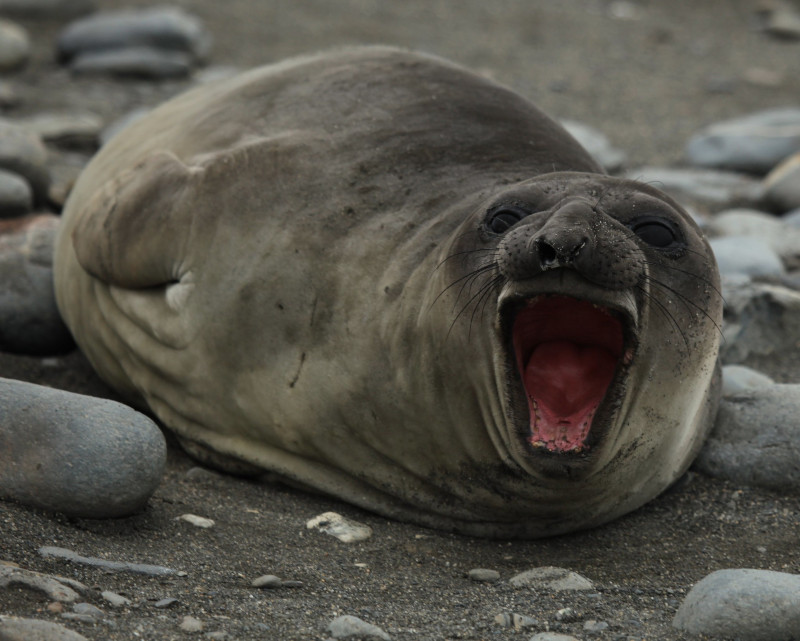
Southern Elephant Seal Facts
- This magnificently massive mammal is most often known by the simultaneously informative and descriptive title of Southern Elephant Seal. It has no other currently accepted general name. At one time, though, some people also knew it as the bottle-nosed seal.
- Within the scientific community, however, it’s generally much better known by its purely technical appellation. Unfortunately, that, like many such, is somewhat hard for the layperson to pronounce. That’s because it holds the official moniker of Mirounga leonina.
- The powerful pinniped received that moderately tongue-twisting epithet due to the efforts of Carl Linnaeus. The renowned Swedish zoologist accomplished the first recognition of it as a separate and distinct species. That scientifically noteworthy deed occurred in the year 1758.
- Regardless of which of these designations one chooses to use, it remains an extraordinary creature. The animal presently represents the largest known surviving marine mammal that isn’t a cetacean. That statistic alone distinguishes it from its relatives around the globe.
- For the moment, the marvelous Southern Elephant Seal appears to still be maintaining a population base that’s currently sufficient. That situation also seems to hold true throughout the entirety of its range. The IUCN thus lists the animal as Least Concern on its Red List.
- That pleasant situation might change in the near future, however. That’s due to the unfortunate fact that its population shows a steady decline for as yet undetermined reasons. The amazing mammal also now faces the same threats from climate change as all species on earth.
Related Articles
Leopard Seal
Southern Elephant Seal Physical Description
The remarkable Southern Elephant Seal never fails to impress and amaze those people fortunate enough to view one of these wonders. Like many of its kindred, though, it does so for several reasons. The awesome animal boasts both an intriguing appearance and astonishing physical size.
It also stands out in that particular regard, as well. This stunning pinniped displays what’s likely the greatest degree of the phsyiological trait of sexual dimorphism of any extant mammal! In its specific case, this particular characteristic manifests itself in terms of sheer body measurements.
That’s true since males of the fascinating species attain an average body mass equaling 5 -6 times that of their female counterparts! Their close cousins, the Northern Elephant Seal, follow a similar pattern. Among that species, though, males only reach 3 -4 times the mass of the females.
The males of this species, however, also known as bulls, typically range in weight from a truly astounding 3,300 – 8,200 lb (1,500 – 3,700 kg). Yet the females merely manage masses averaging from approximately 770 – 1,980 lb (350 – 900 kg). That’s still quite impressive itself, though!
But it’s not just the weight of this breathtaking creation of Nature and evolution that draws attention. It’s also possessed of a lengthy body, as well. Being smaller, females average 8.5 – 9.8 ft (2.6 – 3 m) in length. The males, meanwhile, have mean lengths measuring 14 – 19 ft (4.2 – 5.8 m).
Otherwise, the genders of the breathtaking Southern Elephant Seal present the same general appearance to the observer. The fur of newborn specimens shows as black, while that of adults displays a mix of brown and gray. Yet, among older individuals, this has a leather-like texture.
The animal also possesses the highly enlarged proboscis, though it’s still notably smaller than its cousin. Its eyes evolved as deep black, rounded, and comparatively large. Its hind limbs merge into the tail and fin, while each of the fins that serve as feet has five long, slightly webbed fingers.
- Kingdom: Animalia
- Phylum: Chordata
- Class: Mammalia
- Order: Carnivora
- Family: Phocidae
- Genus: Mirounga
- Species: M. leonina
Southern Elephant Seal Distribution, Habitat, and Ecology
The stunning Southern Elephant Seal evolved as native to a comparatively remote range of the earth’s surface. That precise zone of habitation it inhabits likely won’t surprise many people, though. That’s because, as its name implies, it developed as native to the earth’s southern areas.
In point of fact, it possesses a circumpolar distribution. It’s principally found on numerous subantarctic islands. These include such remote locations as Prince Edward Island and the Falkland Islands. In other parts of its range, this includes Macquarie Island and the Auckland Islands.
This decidedly impressive creation of Nature and evolutionairy processes dwells in a harsh, normally extremely inhospitable environment. Most individuals spend the vast majority of their time at sea. There, it lives in open areas of the ocean, and even resting by floating on the surface.
When swimming, however, most examples of this wonder frequently spend much of their time within a specifc depth range. These average specimens both swim and hunt at depths that range from 1,300 – 3,300 ft (400 – 1,000 m). Exceptional one’s though, dive as deep as 7,835 ft (2,388 m).
Like its multiple relatives across the world, the mighty Southern Elephant Seal evolved as a pure carnivore. Its primary prey consists of quantities of fish and small squid. In this, it seems to be a purely opportunistic hunter, consuming any species of either it can manage to catch and consume.
In turn, its own predators understandably remain comparatively few in number, due to its impressive size. Very young individuals sometimes fall victim to Orcas. Among adults, however, the Great White Shark comprises one of the few natural hunters it needs fear on a regular basis.
Species Sharing Its Range
Check out our other articles on 5 Beautiful Black Sea Species, Great Potoo, Okefenokee Swamp, Agile Ground Mantis, Strawberry Tree, Alligator Snapping Turtle, Axolotl, Executioner Wasp
